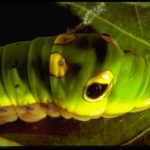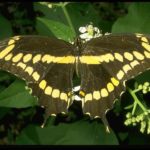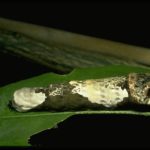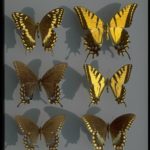Common Name: Giant Swallowtail Butterfly
Scientific Name: Papilio cresphontes Cramer [Sometimes the genus Heraclides is used.]
Order: Lepidoptera
Description: This adult butterfly is one of the largest swallowtail species, with a wingspan of up to 6 inches. Wings are black with yellow markings near wing margins and spots forming a diagonal band across the fore wings. Caterpillars are dark brown with creamy white mottled markings, making them appear much like bird droppings. When disturbed, caterpillars display a pair of horn-like, orange glands (osmeteria) which emit a foul smell.
Other black and yellow swallowtail butterflies include the common tiger swallowtail, Pterourus (Papilio) glaucus (Linnaeus), which has a 3-1/2 to 4 inch wingspan and fore wings that are mostly yellow and marked with 4 black lines and wing margins. Females occur in two forms (dimorphic), one similar to the male but with larger blue markings on the hind wings, and the other an all black form with similar blue markings on the hind wings.
A remarkably similar species is the “two-tailed swallowtail”, Pterourus (Papilio) multicaudatus (Kirby); although this species has reduce black stripe markings and each hind wing has two well-developed tails rather than one. It is more common in the canyon bottoms of west Texas.
In the swampy woods of eastern Texas Gulf Coast counties, the palamedes swallowtail, Pterourus (Papilio) palamedes (Drury), is a common black-brown swallowtail with yellow markings forming a band near the middles of the wings (made of spots on the fore wings but solid on the hind wing) and crescent-shaped spots closer to and along the wing margins. Like the black and blue spicebush swallowtail, Pterourus (Papilio) triolus (Linnaeus), caterpillar stages feed on sassafras. However, caterpillars of the latter also feed on spicebush and are marked with two pairs of large black-ringed and yellow-orange eyespots (first pair black in center and second lacking center spot) and smaller black-ringed blue spots along the body. They roll up leaves to make nests for hiding.
Life Cycle: Adult females lay yellow-green eggs singly on host plants. Caterpillars hatch and develop through several stages (instars) before forming a chrysalis or pupa, which is attached to the host plant by the back end and held in an upright position by a silk thread around the middle.
Habitat and Food Source(s): Caterpillars feed on leaves of host plants including citrus; gas plant, Dictamnus; prickly ash, Xanthoxylum sp.; and rue, Ruta graveolens.
Pest Status: Caterpillars feed on leaves of citrus.
For additional information, contact your local Texas A&M AgriLife Extension Service agent or search for other state Extension offices.
Literature: Howe 1975. Wright 1993.
- Spicebush swallowtail, Papilio troilus Linnaeus (Lepidoptera: Papilionidae), caterpillar. Photo by Drees.
- Giant swallowtail, Papilio cresphontes Cramer (Lepidoptera: Papilionidae), adult. Photo by Drees.
- Orange dog, Papilio cresphontes Cramer (Lepidoptera: Papilionidae), caterpillar. Photo by Drees.
- Swallowtail butterflies, (Lepidoptera: Papilionidae). Photo by Drees. Top: palamedes swallowtail, Papilio palamedes Drury; Papilio multicaudatus Kirby; Middle: tiger swallowtail, Papilio glaucus Linnaeus; Bottom: spicebush swallowtail, Papilio troilus Linnaeus.



